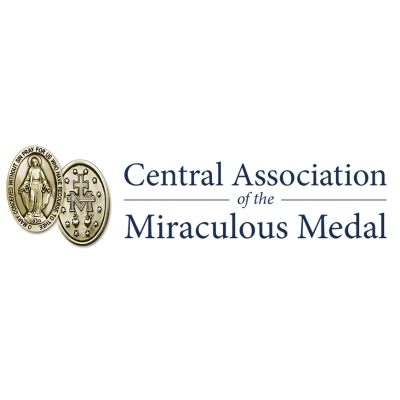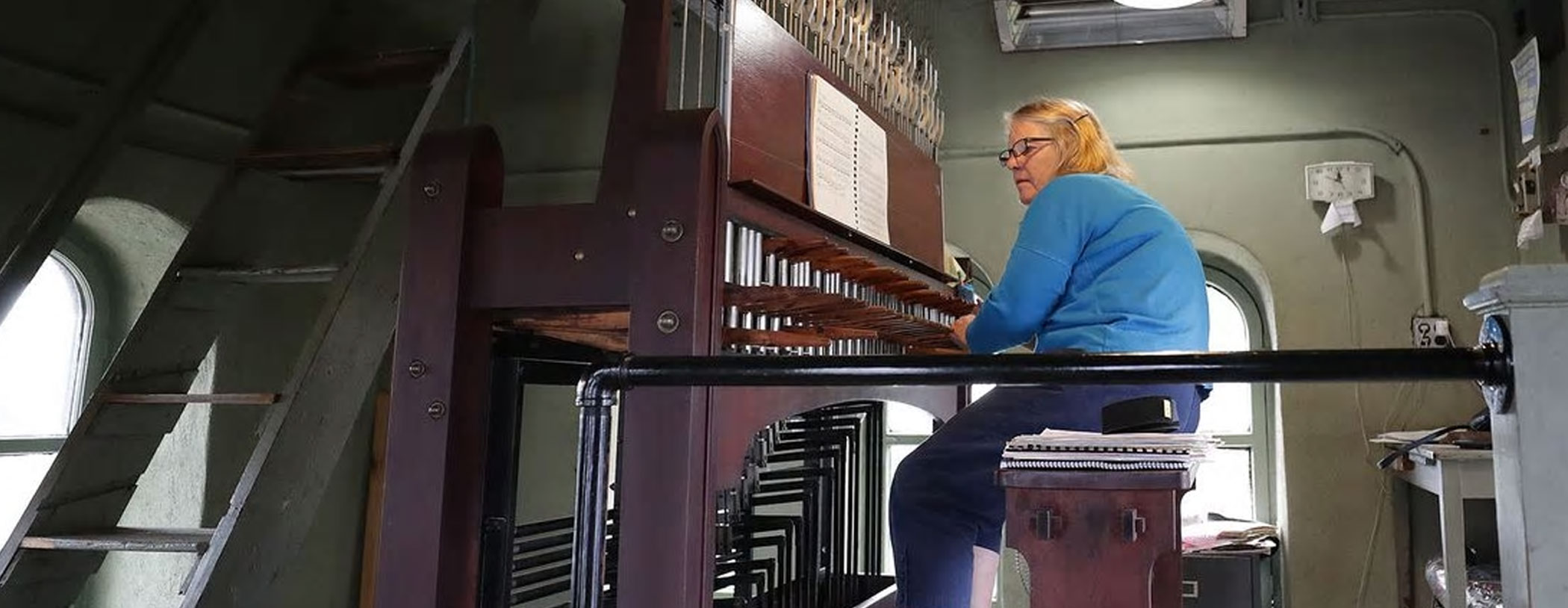The Bells Toll for Thee
While many enjoy the “boom and tinkle” of the Shrine’s carillon, few know the storied history of this melodious, towering instrument.
MARIAN HYMNS FROM ABOVE: THE MIRACULOUS MEDAL SHRINE’S CARILLON
Every Monday evening, residents and visitors in the Germantown section of Philadelphia, which surrounds The Miraculous Medal Shrine, hear the Ave Maria and other Marian hymns in melodious splendor, cascading downward from high above. What they are hearing is a live performance of the Shrine’s very own carillon, emanating from its 125-foot bell tower topped by a 14-foot bronze statue of Mary Immaculate.
Designed to be heard only outside of the Shrine, this carillon consists of forty-seven stationary bells manually played by a carillonneur, who uses both fists and feet to press keyboards and pedals attached to clappers that strike the bells. In fact, only manual carillons like the one at the Shrine—as opposed to automated ones—are recognized as traditional carillons by the Guild of Carillonneurs in North America.
One of the oldest carillons on the continent (the original bells are more than a century old), the Shrine’s carillon has become a neighborhood fixture, welcoming visitors and neighbors alike to Monday evening Mass and the Perpetual Novena to Our Lady of the Miraculous Medal.
As one long-ago observer wrote, “It seems most fitting that the crowds hurrying to and from the Novena devotions should enjoy the hymn melodies tumbling from the high tower over the Shrine. Our bells boom and tinkle right in the midst of the bustle of modern city life, just as the Old World carillons sound in the marketplaces of the quaint town.”
A VINCENTIAN PILGRIM, A CHARITABLE “DAUGHTER”
In the late 1890s, a Germantown-based Vincentian (by some accounts, the unnamed Vincentian was still a seminarian) was on a European pilgrimage to sites related to St. Vincent de Paul. While in France, this Vincentian visited the Church of Notre Dame in Buglose, France, and was inspired by the church’s sixty-bell carillon. Upon his return to Philadelphia, he and parishioners from a local parish persuaded the Vincentians to install a bell tower and carillon in St. Vincent’s Seminary Chapel in Germantown, which would eventually become The Miraculous Medal Shrine.
While many enjoy the “boom and tinkle” of the Shrine’s carillon, few know the storied history of this melodious, towering instrument.
Parishioners from a nearby parish pledged money as memorial offerings. One parishioner, Margaret Ellen Maguire, pledged $5,000 from an inheritance she received from her father, who owned a thriving liquor business, stipulating that the money be used specifically for the carillon. (Maguire would later devote her life to God, joining the Daughters of Charity of St. Vincent de Paul.)
The construction of the 125-foot bell tower was completed in 1899. In 1900, a carillon of twenty-six bells was ordered from the renowned Paccard Foundry in France (twenty-three bells are the minimum for a carillon). These twentysix original bells were, and remain, dedicated to Maguire’s father, John Maguire. Adorned with beautiful artwork, eleven of the original bells are inscribed with the names of saints, while the other fifteen are named in honor of the original fifteen Mysteries of the Holy Rosary.
The bells were blessed on March 25, 1901, the feast of the Annunciation of the Blessed Virgin Mary, and, befittingly, the carillon’s inspired music debuted on Easter Sunday, April 7, 1901.
However, the carillon was often silent during its first forty years due to problems in the mechanical workings of the bells, upgrades, and experiments with new systems. When Prohibition (1920-1933) outlawed alcohol in the United States, the bells were entirely silenced, since the original donation for the carillon came from a pre-Prohibition liquor business. The silence of the carillon was eventually ended by an engineer, carillon expert, and admirer of the Vincentians, Arthur Lynds Bigelow.
On September 1, 1943, Bigelow sent a letter to the Vincentians stating: “I am sending you a complete report on the bells of the Novitiate in Germantown. You will find enclosed a graph tabulating the harmonics of each bell, as we found them […] It is a shame that such a series of bells, such as you are so fortunate to have, be allowed to hang mute without realizing some of the pleasure they could afford. […] They are museum pieces, useless, just meant to be looked at. […] They are a meaningless nothingness, as void as the great bays in the tower in which they hang. I have already said too much. I’ll let the report say the rest.”
Years before he sent that letter, Bigelow and his wife (who he called “Jo”) owed their lives to the Vincentians. Fleeing Hitler’s invasion of Belgium in 1939, the Bigelows rode a tandem bike more than a thousand miles to the south of France, where they hoped to board a ship for America.
Along the way, the couple met two American Vincentian Priests, who suggested the couple stop at any Vincentian house in France for help and directions during their arduous journey. Weeks later, the Bigelows stopped at a Vincentian house in Dax, the childhood home of St. Vincent de Paul. There they found asylum with the Vincentians, and because fleeing the country was difficult, they stayed with the Vincentians for a year. During that time, Bigelow seized the opportunity to study the carillon bells in Buglose, France—the same carillon tha had inspired the American Vincentian on pilgrimage nearly half-a-decade before.
In Bigelow’s own words: “It just so happens that I lived that last year in France, in full German occupation, in that part of southern France where the Paccard carillon was. I often cycled the 12 miles each way to take notes on it and test the bells. […] When I first come (sic) to Princeton (1941) and learned that there was a community of Saint Vincent here, I immediately got in touch with the father […] Sometime afterwards it came to my attention that in their seminary in Germantown there was a carillon of French bells, which had long since completely fallen in disuse.”
In 1943, Bigelow studied the Shrine’s carillon, offering the Shrine’s director, Fr. Joseph A. Skelly, CM, a full report on what was needed to get the bells ringing again, while suggesting the Vincentians expand the carillon to forty-seven bells (almost four octaves). Fr. Skelly agreed. All the bells were soon removed, the steel framework shored up, and the wooden beams replaced by new oak beams. Two new, larger bells were ordered from the Paccard Foundry. While in his Princeton studio, Bigelow recast two of the original Paccard bells, and cast twenty-one smaller, upper bells. The installation of the new bells and keyboard was completed in 1952, and the updated and expanded carillon was first played for the public on June 15, 1952, with Bigelow as the carillonneur.
HISTORIC, MODERN, AND MARIAN
Since 2002, the Shrine’s historic carillon has been played by carillonneur Janet Tebbel, who each Monday evening enters the Shrine and climbs more than seventy steep steps to reach the manual keyboards and pedals. She is alone in the bell tower, situated stories above the many pilgrims who enter the Shrine for the Monday evening Mass and Novena.
However, Tebbel finds the accommodations in the tower to her liking. “The tower has a small fan and a few windows that open,” says Tebbel. “I sometimes get a nice breeze. The heating is nicer, and there are glowing heat tubes, which can keep it almost comfortable up there, unless the wind is creating drafts. I have never had to leave the Shrine tower during a thunderstorm, because I am on a wooden platform in a stone tower with lightning rods, which deflect any problems—I hope.”
Tebbel had a calling to become a professional carillonneur. “I started studying carillon at the University of Michigan, but I always knew what it was because I grew up with a neighboring town, Bloomfield Hills, Michigan, boasting two active carillons,” she says.
“I continued to play while at the University of Rochester and then went to Belgium to obtain a carillon diploma from the carillon school. I have been the carillonneur of the First United Methodist Church of Germantown for forty years, and I have played at the Shrine since 2002.”
When Tebbel is deciding what to play, she likes to keep it fresh and engaging. ”In my playing time of almost ninety minutes,” Tebbel says, “I will play carillon compositions, arrangements of known songs, transcriptions of classical pieces, and compositions based on hymns of the Church. I try to vary the style and mood.”
What she chooses to play on the famed instrument is also dictated by the bells themselves. “Bells are quite idiosyncratic in their sound and, therefore, we have to be careful when we play arrangements. There are many beautiful arrangements of hymns, songs of the Church, and popular songs. Transcriptions of classical music can be successful if done carefully. We have a wealth of compositions specifically for the carillon but, again, they have to be carefully selected and practiced in order to be accessible to a listener on the ground, who has no program to give any clue as to what they are hearing.”
Tebbel is also cognizant of the Shrine’s devotion to the Blessed Mother and its increasing multi-ethnic appeal. “I always begin my playing sessions at the Shrine with one of our Marian hymns and the Ave Maria. Since the fire at Notre Dame [in Paris, France, on April 15, 2019], I have also frequently played the [French version of the] Ave Maria, which people sang on the [Parisian] streets as the fire raged. I have a collection of Latino hymn arrangements, which are fun to play and, I hope, to hear.”
Much like the Shrine itself, while the carillon harkens back to a long-ago age, it remains relevant today. “The Shrine’s carillon is unique in many ways,” notes Tebbel, “both historic and modern at the same time.”


